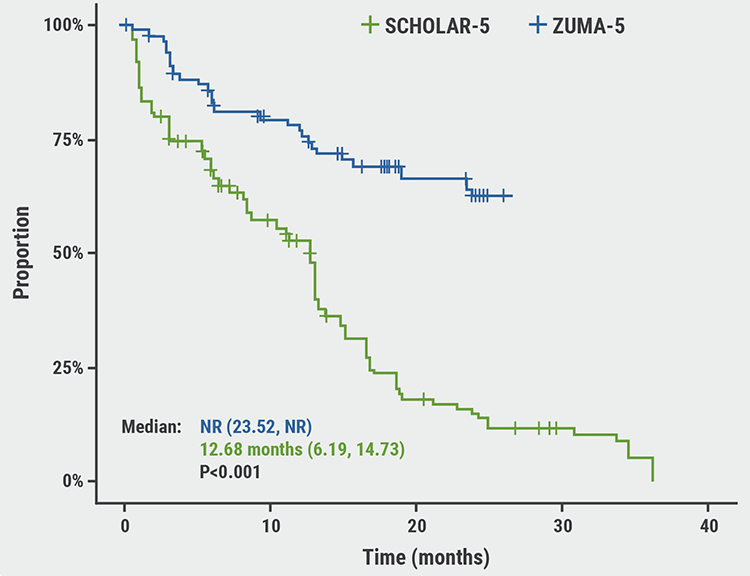https://doi.org/10.55788/504b3b37
“The 5-year progression-free survival (PFS) rate for patients with high-risk DLBCL is around 60%,” opened Dr Marcel Nijland (University Medical Center Groningen, the Netherlands) [1]. He shared that the incidence of relapse is around 25% for high-risk patients in clinical remission after R-CHOP and that lenalidomide maintenance and polatuzumab vedotin added to R-CHOP improve PFS but not overall survival [2,3].
The phase 2 HOVON 151 study (NL6335204217) investigated the efficacy of consolidation therapy with the PD-L1 inhibitor atezolizumab in participants with high-risk DLBCL who had a CMR after R-CHOP therapy (n=109). The participants received 1,200 mg of atezolizumab, intravenously administered every 3 weeks, for up to 18 cycles. The primary endpoint was DFS and Dr Nijland presented the study's final analysis [1].
The 2-year DFS rate was 87.9% (90% CI 81.5–92.1), meeting the primary endpoint (see Figure) and surpassing the 2-year DFS rate from a historical cohort (≤79%) [4]. Moreover, the 2-year overall survival rate was 96.3% [1]. Dr Nijland added that 13 of the 15 relapsing participants received salvage chemotherapy, of whom 77% experienced a second CMR.
Figure: Kaplan-Meier curve of disease-free survival in HOVON 151 [1]

Adverse events were reported in 79% of the participants, most commonly being infections (25%), musculoskeletal and connective tissue disorders (9%), and nervous system disorders (9%). The research team noted 10 cases of endocrinopathy and 3 ocular toxicities during the study.
Atezolizumab consolidation therapy after R-CHOP yielded excellent results in participants with high-risk DLBCL who achieved a CMR on R-CHOP. The remarkable 2-year overall survival outcomes and the fact that most participants were chemo-sensitive at relapse support atezolizumab as a consolidation therapy for this population.
- Nijland M, et al. Feasibility and clinical efficacy of atezolizumab consolidation in high risk diffuse large B-cell lymphoma: final analysis of the HOVON 151. S236, EHA congress 2024, 13–16 June, Madrid, Spain.
- Thieblemont C, et al. J Clin Oncol. 2017;35(22):2473–2481.
- Tilly H, et al. N Engl J Med. 2022;386(4):351–363.
- El-Galaly TC, et al. J Clin Oncol. 2015;33(34):3993–3998.
Copyright ©2024 Medicom Medical Publishers
Posted on
Previous Article
« First results for zanubrutinib plus venetoclax in del(17p)/TP53-mutated CLL/SLL Next Article
Can golcadomide plus R-CHOP become the first-line standard of care in high-risk BCL? »
« First results for zanubrutinib plus venetoclax in del(17p)/TP53-mutated CLL/SLL Next Article
Can golcadomide plus R-CHOP become the first-line standard of care in high-risk BCL? »
Table of Contents: EHA 2024
Featured articles
Meet the Expert: Prof. C. Ola Landgren discusses MRD as a key endpoint in haematological cancer trials
Multiple Myeloma
Isa-VRd proves its value in newly diagnosed MM in the IMROZ trial
PERSEUS: High MRD negativity rates with D-VRd and consolidation therapy and D-R maintenance in MM
Post-intensification data confirm superiority of quadruple therapy in MM
Promising phase 1 results for novel CAR T-cell therapy in MM
DREAMM 8: Belantamab mafodotin offers hope for patients with RRMM
Leukaemia
PhALLCON: Third-generation TKI superior to first-generation TKI in Ph+ ALL
APOLLO: ATRA plus ATO meets expectations in high-risk APL
Excellent phase 3 results for asciminib in chronic myeloid leukaemia
AUGMENT-101: Revumenib trial in KMT2Ar leukaemia stopped early for efficacy
FLAG-Ida plus venetoclax induces high MRD-negativity rates in AML
CD40/CD47 inhibitor shows promise in high-risk MDS and AML
ENHANCE: Magrolimab does not ameliorate health outcomes in high-risk MDS
Can MRD-guided azacitidine treatment improve outcomes in AML and MDS?
Can WGTS replace standard-of-care diagnostics in AML?
Non-malignant Haematology
ENERGIZE: Mitapivat meets primary efficacy endpoint in thalassaemia
Sovleplenib delivers durable responses and QoL improvements in primary ITP
Avatrombopag successful in children with chronic ITP
RUBY: Promising data for first AsCas12a gene-editing therapy in sickle cell disease
Encouraging data for ELA026 to treat secondary haemophagocytic lymphohistiocytosis
Myelofibrosis
Navitoclax plus ruxolitinib leads to spleen volume reductions in myelofibrosis
Is pelabresib plus ruxolitinib the paradigm-shifting combo therapy for myelofibrosis?
Lymphoma
The landscape of TP53 mutations and their prognostic impact in CLL
Can golcadomide plus R-CHOP become the first-line standard of care in high-risk BCL?
High survival rates following atezolizumab consolidation in DLBCL
First results for zanubrutinib plus venetoclax in del(17p)/TP53-mutated CLL/SLL
EPCORE CLL-1: Promising data for epcoritamab in high-risk Richter’s transformation
Updates from the EBMT Lymphoma Working Group: outcomes after allo- and auto-SCT for T-cell lymphoma subtypes
ECHO: Can we expect a novel standard of care in newly diagnosed MCL?
Clinically meaningful outcomes for mosunetuzumab across follicular lymphoma subgroups
© 2024 Medicom Medical Publishers. All rights reserved. Terms and Conditions | Privacy Policy
HEAD OFFICE
Laarderhoogtweg 25
1101 EB Amsterdam
The Netherlands
T: +31 85 4012 560
E: publishers@medicom-publishers.com


